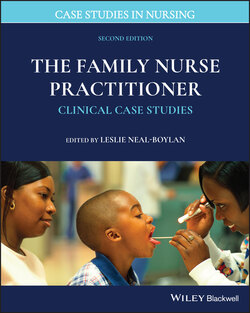Читать книгу The Family Nurse Practitioner - Группа авторов - Страница 37
ОглавлениеCase 4.6 Cough and Difficulty Breathing
By Nancy Cantey Banasiak, DNP, PPCNP‐BC, APRN
SUBJECTIVE
Emily is a 6‐year‐old female who presents to the clinic with her mother. She presents with complaints of cough and difficulty breathing. Two days prior, Emily developed a nonproductive cough that is worse at night, clear rhinorrhea, and a fever with a maximum temperature of 102°F. The mother has treated the fever with Tylenol 320 mg every 4 hours, as needed, when the temperature was greater than 101°F. Her mother also complains that “when she gets a cold, it lasts longer than normal.”
Birth history: Emily was born full term weighing 3200 g by normal spontaneous vaginal delivery (NSVD). Pregnancy and delivery were uncomplicated with Apgar scores of 8 (1 minute) and 9 (5 minutes).
Social history: Emily is a 6‐year‐old female in the first grade who lives with her mom, dad, and 2 siblings in a house in the city. They have 4 pets: 2 dogs, 1 cat, and 1 turtle. The parents work outside the home and have private health insurance. Emily and her siblings attend an after‐school program until her mom picks them up after work. Emily attends regular medical and dental appointments, and they deny tobacco or alcohol use in the home. She plays soccer, ice hockey, and lacrosse.
Diet: Emily’s appetite is fair with a fluid intake of 32 oz/day of juice/milk/water. She also reports normal eating habits without abdominal pain or diarrhea.
Elimination: Emily voided 4 times yesterday. No vomiting or diarrhea. Her mother complains that everyone in the house is sick with the same symptoms.
Sleep: Emily sleeps from 8 p.m. to 6 a.m. She coughs 1–2 times during the night.
Past medical history: Past medical history is positive for obstructive sleep apnea 4. Birth history was uneventful. Emily also has a history of bronchiolitis at 8 months of age, which did not require medication or hospitalization.
Family history: Mother (age 36): healthy, atopic dermatitis, seasonal allergies; father (age 35): healthy, asthma, seasonal allergies; sibling (age 4): healthy; sibling (age 2): healthy; maternal grandmother (age 80): hypertension, breast cancer, basal cell skin cancer; maternal grandfather (age 81): hypertension, diabetes mellitus Type 2; paternal grandmother (age 76): hypertension, obesity; paternal grandfather (age 72): deceased, hypertension, stroke.
Medications: Emily is currently on no medications. Immunizations are up to date.
Allergies: Has no known allergies to medications, food, or the environment.
OBJECTIVE
General: Emily is alert, well hydrated, active, and cooperative.
Vital signs: Temperature 38°C, pulse 72, and respirations 28 per minute with a blood pressure of 100/52 in the left arm. The O2 saturation is 94%, and weight is 25 kg.
Skin: No lesions, rashes, or scars; and the patient is not cyanotic.
HEENT: Normocephalic with no evidence of trauma or lesions. Eyes show no signs of drainage; sclera white, with pink conjunctiva. Otoscopic examination reveals tympanic membranes gray bilaterally with positive light reflex and normal pinnae. The nose has clear rhinorrhea; no nasal polyps with pink turbinates. Examination of the throat shows a cobblestone appearance in the posterior pharynx, uvula midline, tonsils size 0/4 with no exudate or erythema, moist mucous membranes; and the trachea is midline.
Respiratory: Bilateral inspiratory and expiratory wheezing; mild intercostal retractions; mild shortness of breath; no rales, crackles, or nasal flaring.
Cardiovascular: No murmur; normal S1/S2; 2+ brachial and femoral pulses; no cyanosis, clubbing, or edema noted.
Lymphatic: There is no lymphadenopathy on examination.
Abdomen: Soft, nontender, nondistended; + bowel sounds; no hepatosplenomegaly during palpation.
Genitourinary: Normal female genitalia.
Neurological: Grossly intact.
CRITICAL THINKING
1 What diagnostic or imaging studies should be considered to assist with or confirm the diagnosis?___Oxygen saturation___Chest X‐ray___Nasal pharyngeal swab for direct fluorescent antibody (DFA)
2 What are the top differential diagnoses and why?
3 What is the most likely differential diagnosis and why?
4 What is the plan of treatment?
5 What is the plan for follow‐up care?
6 Are any referrals needed at this time?
7 Are there any standardized guidelines that should be used to assess or treat this case?
